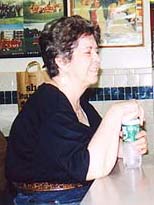Millikin University Haiku Writer Profile
Ellen Compton
|
|
This profile of haiku writer, Ellen Compton, was researched, written and created by Cathy Sadowski. Cathy Sadowski 's study of Compton's haiku. Scroll through the entire profile, or jump to any section:
|
|||||||||||||||||||||||||||||||||||
|
Tanka Splendor 1991, 1992, 1994, 1995; San Francisco International (HPNC), Honorable Mention 1995; Penumbra, Honorable Mentions 1996, 1998, 1999 Ellen Compton-Tejera was born in Wheeling, West Virginia, and lived there as well as in nearby Ohio until she was ten. Her father was a mining engineer whose assignments took the family from one small coal town to another—usually for a year in each place. The towns her family lived in bore the scars so typical of the communities in and around underground coal mines, yet they existed in a great river valley and among hills of incredible beauty. She credits such contrasts with forming within her a deep love for the natural world and a commitment to its preservation. After her father’s death, Compton’s mother’s need for wider employment opportunities brought the family to Washington, DC. Here she finished her formal schooling. In college she majored in Fine Arts and Theater Arts. For several more years she continued to study painting and, occasionally, to do some theater work. Her family also found a second home in a small cabin on the Western Shore of the Chesapeake. The years of marriage to a Venezuelan national took her to New Orleans, Caracas, Troy (in Upstate New York), a mountain top in western New Jersey, and back to Washington. It was in this period that Compton began to read the beat poets who introduced her to haiku and the masters. She became a closet haijin at first, but a look into Cor van den Heuvel’s Haiku Anthology brought her into the open. Upon
her return to Washington she began the publications work that eventually
led to self-employment as a freelance writer. Compton has written
on conservation, environmental preservation, and the social sciences.
In recent years she has developed manuals for computer users who
know as little about computers as she does. Working freelance, from
her home office, means that she can create time for the things she
loves—and haiku is at the top of that list. Compton has also
written and published tanka, is one of the founding members of the
"towpath" haiku group, and currently serves on the editorial
staff of the Red Moon Anthology. |
|||||||||||||||||||||||||||||||||||
|
|
Compton finds haiku moments wherever she has lived or traveled, even in her own kitchen! The Maryland shore of the Chesapeake Bay has played a major role in this as well. Compton admits that few of her poems would suggest that they are "urban haiku" at first glance, but many others are drawn from her life in Washington D.C. where parks, garden and other natural areas exist along side the monuments. Sights, sounds, smells, and textures speak to her on many levels. Compton says that "behind the taste of an orange is a history of dormancy and awakening, a scent of blossoms; beyond it is the possibility that lies in its seeds. Run your fingers over an empty clamshell and read another little history. Do we somehow hear the tundra in the cries of wild geese on migration? Seen up close, a vulture is not particularly attractive, yet in flight it has a certain grace, and as scavenger it is an important part of the economy of nature." She is also inspired by the great Japanese masters, old and new, and has returned many times to poems such as Chiyo-ni’s
(translation by P. Donegan and Y. Ishibashi, in Chiyo-ni: Woman Haiku Master) and Yatsuka Ishihara’s
(translation by T. Kondo and W. Higginson, from Red Fuji) Why Write Haiku?Compton listed several reasons for writing haiku:
See Cathy Sadowski's complete essay on Compton. |
|
Additional Web Links and Resources (to be added later) |
| © 2001, Dr. Randy Brooks• Millikin University |
last
updated 8/16/01 • about this web site
|
